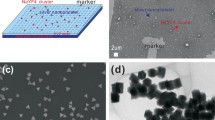Abstract
Near-infrared-to-visible upconversion materials have many promising applications, including use in luminescent solar concentrators, in next-generation displays, and as biological labels. NaYF4 nano-particles doped with Yb and Er exhibit efficient upconversion and are easily deployed in these applications. It is known that a rough metal surface may increase the yield of fluorescence of a nearby fluorophore, by local field enhancement due to plasmonic resonances, and by modification of the radiative rate(s) of the fluorophore. Thus, properly chosen metallic nanostructures can potentially increase the upconversion efficiency of lanthanide-doped nanoparticles, yet the optimal design of these nanostructures is still an active area of research. In our experiments, we use a spectroscopic imaging system to study the upconversion efficiency of NaYF4: Er3+/ Yb3+ through spatially-resolved upconversion spectra, using a custom-built scanning confocal microscope system with infra-red excitation, and wide-field fluorescence imaging. We present spectrally-resolved upconversion images of NaYF4:Yb3+/Er3+ nanoparticles on plasmonic substrates, including silver nanowires and patterned substrates of gold and silver, which show localized regions (~ 1µm) of relatively stronger intensity and modified upconversion spectra, and compare these to wide-field fluorescence images of samples with and without plasmonic substrates.
Similar content being viewed by others
References
S. Baluschev, T. Miteva, V. Yakutkin, et. al., “Up-Conversion Fluorescence: Noncoherent Excitation by Sunlight,” Phys. Rev. Lett. 97 143903 (2006).
Antonio Luque and Antonio Marti’, “Increasing the Efficiency of Ideal Solar Cells by Photon Induced Transitions at Intermediate Levels,” Phys. Rev. Lett. 78 (26) 5014 (1997).
R.W. Peng, M. Mazzer, K.W.J. Barnham, “Efficiency enhancement of ideal photovoltaic solar cells by photonic excitatons in multi-intermediate band structures,” Appl. Phys. Lett. 83 (4) 770 (2003).
R. D. Schaller and V. I. Klimov, “High Efficiency Carrier Multiplication in PbSe Nanocrystals: Implications for Solar Energy Conversion,” Phys. Rev. Lett. 92 186601 (2004).
Richard D. Schaller and Victor I. Klimov, “Non-Poissonian Exciton Populations in Semiconductor Nanocrystals via Carrier Multiplication,” Phys. Rev. Lett. 96 097402 (2006).
G.B. Smith,” Materials and systems for efficient … delivery of daylight” Solar Cell Mat., 84 395 (2004).
Lakowicz, J.R, “Radiative decay engineering: biophysical…applications” Analytical Biochemistry 298 1 (2001).
K. Aslan, J,R. Lakowicz, C.D. Geddes, “Metal-enhanced fluorescence using anisotropic silver nanostructures: critical progress to date”, Anal. Bioanal. Chem. 382 926 (2005).
Cuikun Lin, Mary T. Berry, Robert Anderson, Steve Smith, and P. Stanley May, “Highly Luminescent NIR-to-Visible Upconversion Thin Films and Monoliths Requiring No High-Temperature Treatment,” Chem. of Materials 21 (14), 3406–3413 (2009).
Author information
Authors and Affiliations
Corresponding author
Rights and permissions
About this article
Cite this article
Zhong, L., Luu, Q., Paudel, H.P. et al. Imaging Upconversion from NaYF4:Er:Yb Nanoparticles on Au and Ag Nanostructured Substrates. MRS Online Proceedings Library 1342, 408 (2011). https://doi.org/10.1557/opl.2011.997
Published:
DOI: https://doi.org/10.1557/opl.2011.997




